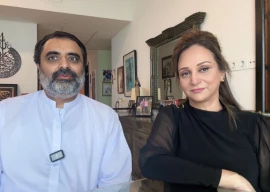
As the metal grill door in the dark landing of Tasadaq Sohail’s humble Karachi flat clanged open, I waited patiently to be let in. I wondered if anything had changed in the years since I had last met him. By my calculations he was almost eighty-three years old now — typically, you expect religious fervor to have kicked in and as I stood there I let my imagination run wild. I was already picturing a wise sage, a Gandalf-like persona from Lord of the Rings or some variation of Dumbledore from the Harry Potter movies. Not so.
He peered from behind the door to make sure it was me, and there he was, exactly as I remembered him, unchanged despite a decade’s passing. There he stood, more the mischievous Gollum than the sage Gandalf, as chirpy and roguish as ever.
For those who need an introduction, Sohail is one of the most celebrated artists of his time. His list of one-man shows is endless and impressive, and lately the market for his work has soared greatly with collectors snapping up his paintings even before the paint dries. The V&A Museum and the Art council of Great Britain have included his work in their collection. And he still paints on, as prolific as ever.
His paintings are surreal narratives that dip and dive into the realms of fantasy and fiction. The Devil himself, mermen and mermaids alike, minions and centaurs are all swimming in a sea of wild bewilderment and anguished existence.
Why try to find an anchor for these devilish creations? No heaven could be as naughty and no Hell could be as playful. His paintbrush just cooks up these impish characters that spontaneously tiptoe across his paintings and when you are not looking, snicker and continue cantering on in their demonic way. Quite unreal and quite mischievous is the world of Sohail as it revolves in a giant bowl of what could only be discontentment.
Animated as ever, being eighty-three has not dimmed Tasadaq Sohail’s discontent. He is fierce, feisty and furious all at the same time. One can imagine him burning the midnight oil in his studio lit by gigantic square ceiling lights cooking up revenge on canvas as he viciously squeezes the tubes of paints in a frenzy of creativity.
Angry parrots squawk away and mullah-like figures argue back while grinning politicians watch over you from their canvas prisons. You think all the years of reflection that Tasadaq Sohail has had would have softened his stance but I couldn’t help smiling as he rattled on, plotting his ultimate revenge in life, his autobiography which he has bequeathed to be printed only after his passing. Not before, he grins devilishly, because heads will roll and secrets will be revealed that will be the undoing of many!
But what does a successful artist like Tasadaq have to be angry about? Apparently, a great deal. Religion, Politics, establishment, family and friends that were, are all part of the plot.
He was born in Jalandhar, now a part of India, in October 1930 and his family was reluctantly forced to leave India at partition to come to Lahore. He remembers attending the pre-partition rallies and in true Tasadaq fashion opposes the partition that forced him to uproot himself. A fiercely independent young man, he did not allow his family to force him into marriage and instead escaped to London when he was 25 years old.
In London began Tasadaq’s journey to become the artist he is today. His motivation, as he puts it, was purely lust. He joined an evening art class at St Martin’s college in London on the tip off that the gender ratio was in favour of women and he would, to be plain, get lucky with women.
Tasadaq was lucky in more ways than one. He fulfilled his goal of meeting women but also unlocked his hidden talent in the process. He continued these evening classes for almost 30 years, availing the use of a live model for his paintings. In all these years in the UK he was never really recognised as an artist and held several odd jobs including as a breakfast chef at the Cumberland Hotel and a used clothes salesman at Moss Brothers. I was curious to know if he ever found love and wished to settle down and of course I was brutally struck down for asking so naïve a question. Tasadaq is an eternal romantic capable of being in love with several women at once. He roguishly talks about his first trip to Hira Mandi, the topic of one of his short stories, and loves talking about his current liaisons which are, to put it plainly, many.
Those who know him as a painter would be surprised to know that he is an equally avid writer. His Urdu stories have been in print many times for many years and he loves the written narrative as much as the visual.
The list of Tasadaq Sohail’s achievements goes on but does not seem to have rubbed off on Tasadaq Sohail himself. He does not seem to be too affected by all the publicity he gets. Despite all his success, he claims he has never tried to sell his work at an inflated price, which is very true. He seems confused about the market for art and suspicious of dealers and the ever-present counterfeiters.
But most of all, he is a delightful artist to meet. He has the enthusiasm and the excitement of an artist at his first show. He wants to explain the madness he creates, and almost at times seems to need to defend it. Once you have understood his unconventional play with brilliant color and get past the carelessly drawn lines to see the deliberation of this apparent spontaneity, you will learn to see a different dimension of his work. You will see an artist who has nothing to prove and a boundless talent to display.
Tasadaq Sohail wants to make the most of every second he has. As I leave, he turns and returns to his easel, already lost in the unfinished story unfolding on his canvas.
Ernest Hemingway once talked about the wisdom of old men. He said, “They do not grow wise. They grow careful.” I think Tasadaq Sohail is who he is because he does not care to be careful and is wise enough to have figured that out a long time ago. His paintings are as daring and challenging as his personality and they will live on, ageless and enduring, unfolding their narrative for generations to come.
Published in The Express Tribune, Sunday Magazine, May 6th, 2012.
COMMENTS (3)
Comments are moderated and generally will be posted if they are on-topic and not abusive.
For more information, please see our Comments FAQ








































One doesn't have to look for his name in the corner to know its a work by Tasadaq Sohail. There is something magical about his work and that is what makes an artist. You have done justice in this write up.
Lovely read! He seems like a person who, other than his talent, knows the art of living! Would love to meet him sometime.
Nicely written, with befitting praise. The man is a treat to meet, and a living master.